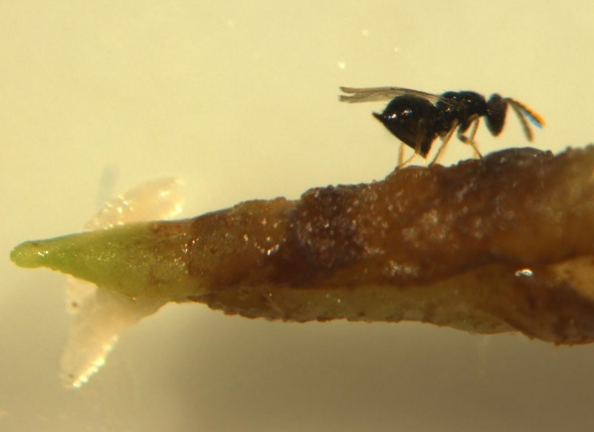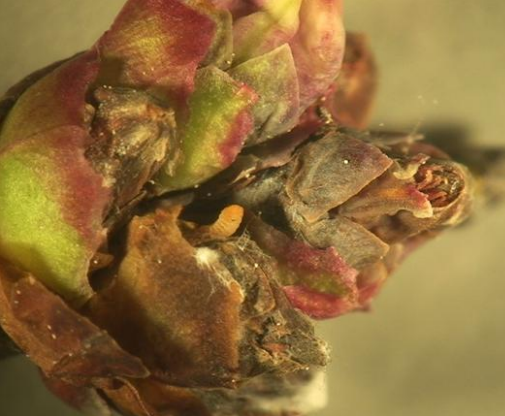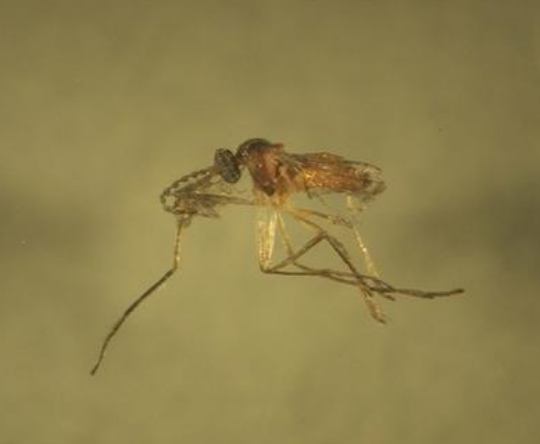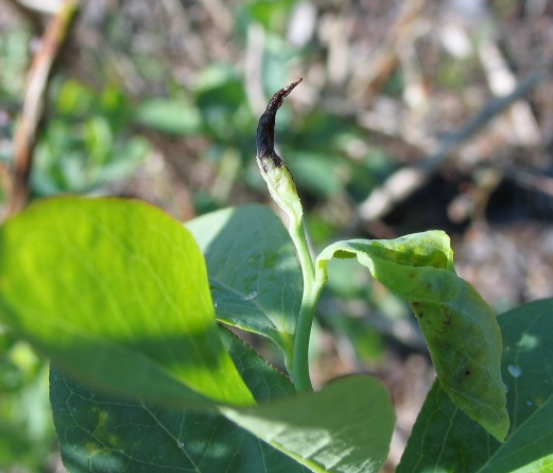Dasineura oxycoccana (Johnson)
Author: Craig Roubos, Ash Sial, Entomology, University of Georgia
Description
Immature stages: Eggs are oval-shaped, transparent and very small. Larvae are legless and white in color when newly hatched. As larvae mature, they darken and become orange by the time they are ready to pupate. Mature larvae have a unique feature called a spatula; a dark hardened structure shaped like a “Y” on the underside near the head.
Adult stages: Adults are 2-3 mm (0.08-0.12 inches) in length and have long slender legs. Their wings are transparent, have few wing veins, and have a fringe of hairs on the hind edge.
Biology
Life Cycle: Adults live for only a few days (less than a week) during which time a single female can lay up to 20 eggs. Eggs are laid within floral or vegetative buds and hatch in 2-3 days. The fully fed mature larva will exit the bud and drop to the ground to pupate in the soil.
Seasonal Distribution: Blueberry gall midge is a small fly that is native to North America. It is distributed throughout the eastern, midwestern and north western United States. Blueberry gall midge was first recognized as a pest of rabbiteye blueberry (Vaccinium virgatum) in the southeastern United States in early 1990s (Lyrene and Payne 1992). It is now recognized as a pest of all cultivated Vaccinium species: highbush blueberry, rabbiteye blueberry, lowbush blueberry, and cranberry. In South Georgia, gall midges can complete 5-6 generations from January through June.
Damage
Floral bud injury can reduce flower production and potential yield. Larvae feed on floral bud tissues and on the pedicels that hold the individual flower buds to the peduncle within the developing flower cluster. As a result, flower buds dry up and disintegrate within about two weeks after infestation. Dormant buds (stage 1) are too tightly packed for blueberry gall midge to lay eggs between the scales. Stages 2 and 3, however, are vulnerable. Later bud stages are too open to provide shelter for eggs and newly hatched larvae.

Vegetative bud injury can affect plant vigor. Infested vegetative buds swell and the outer leaves curl enfolding feeding larvae inside. Vegetative meristems may also be infested and killed leading to distorted and blackened shoot tips. If the apical growing tip is killed, plants will produce more lateral growth. Continual infestation and destruction of vegetative growing tips will result in sparse foliation. Rabbiteye is more susceptible to this type of damage than highbush.
The damage caused by blueberry gall midge in blueberries can be confused with frost damage or boron deficiency. The severity of damage depends on temperature and other climatic factors, and generally tends to be worse after mild winters.
Management
Chemical control of blueberry gall midge can be challenging because eggs and larvae are well-protected inside buds. It is therefore important to time insecticide sprays to target adult midges before they have a chance to lay eggs. Because of blueberry gall midge’s short adult lifespan and multiple generations per season, careful scouting and timing of insecticide application are key to successful control. Insecticides shown to be effective against blueberry gall midge include Diazinon, Delegate® (spinetoram), Entrust® (spinosad), Imidan® (phosmet), Malathion, and Assail® (acetamiprid). However, these insecticides are toxic to bees, so it is extremely important to follow label instructions in order to minimize unintended harmful effects to non-target organisms.
Several species of parasitic wasps attack and kill blueberry gall midge. These are very small wasps (1.5 mm or 0.06 inches long) with shiny black bodies and transparent wings. The adult wasps find the gall midge larvae within buds and sting them. These parasitic wasps can suppress blueberry gall midge populations, but the actual impact will depend on the abundance of these natural enemies in the blueberry orchard.


